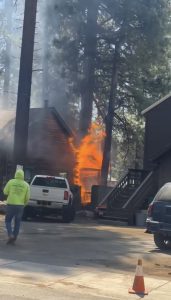Climate Dispatch: Reconnecting with Tahoe’s Forests: From Curiosity to Care, An Earth Month Reflection
A few years ago, while biking up to Stanford Rock with my husband, I admired the forest around us. He mentioned that these weren’t the original trees of the area—Tahoe had been heavily logged, and much of what we see today was planted afterward, not always with the original native species.
This was new information for me, and, curious, I began learning more about Tahoe’s forests. My exploration has unexpectedly enhanced both my sense of connection and enjoyment when I participate in outdoor activities, as well as my awareness about local fire risk.
We have amazing resources and compelling conversations happening locally and at a much broader scale which impact the health of the ecosystems we live and play in. As the snow melts and the forest springs to life, Earth Month is an excellent time of year to explore local ecology and find ways to participate in forest resiliency.
I’d love to inspire your learning journey by sharing some of the resources that have been especially meaningful in my own:
- The overall history of the Tahoe Basin forest provided in the Forest Service article “Tahoe Basin: A Forest’s Past and Future” can provide a helpful starting point.
- I wanted to better get to know the trees that make up the forest.
- This three-part blog series on the Beetles in the Bush site is an excellent resource for learning about the different conifers in our region. It is written by a Missouri entomologist with a passion for spending time in Tahoe forests, and provides simple ways to identify trees according to needle shape and number, cones, and stature. It’s satisfyingly detailed, well-referenced and easy to follow.
- Local path placards are another great resource. Signs on the trail near the Tahoe City post office, for example, explain the difference between Ponderosa and Jefferson pines, highlighting the “Prickly Ponderosa” cones, versus the smoother “Gentle Jefferson” cones.
We can use our senses to touch, smell and observe the trees around us. Bike rides and hikes have become that much more interesting as I test out my new species knowledge!
- It felt important to me to know more about the people who stewarded this area long before it was developed.
- The Wa She Shu (Washoe people) have lived in close relationship with the forest and ecosystems of the Tahoe area for thousands of years. Last summer, I attended one of the monthly Washoe cultural talks at Palisades, where I learned about the land, animals and plants that the Washoe people were and still are in relationship with. The tribe holds deep Traditional Ecological Knowledge (TEK) that offers powerful guidance for living in harmony with our forests.
- Today, the Washoe Tribe works in multitudinous ways to restore ecological resilience in the Lake Tahoe Basin. A Washoe Liaison was established last year to provide a centralized point of contact with the Washoe Tribe. You can learn more about the Washoe people here and about the liaison position here.
- There are a few community groups I’ve joined which provide an excellent way to learn and engage.
- Citizens’ Climate Lobby is a national, non-profit and non-partisan organization that builds political will for climate change action. Their website offers insightful educational resources and videos on forest management and a wide range of climate related issues. Monthly meetings of the local North Tahoe chapter provide an opportunity to learn about federal and local climate issues, including forest health policies and initiatives, and offer impactful ways to get involved.
- The Tahoe Truckee Community Foundation hosts their educational, fun and community-oriented Forest Futures Salons. These events feature storytelling and inspiring conversations with local leaders on topics like forest management and wildfire mitigation. I have been to two so far and have come away from each feeling informed and inspired!
During a time of rising temperatures and increasing wildfire risk, understanding the forest – its history, its needs, what helps it thrive – feels more critical than ever. My learning journey has shifted how I interact with, understand, and care about the forest in meaningful ways. It has also given me an avenue to increase my agency in the future of our ecosystems. Consider what could change if our collective community engaged more deeply with the land, the trees and our non-human kin.
As we step into the warmer months and the forests around us come alive, it’s the perfect time to deepen connection with the land and become active stewards of its future. Whether you start by simply learning the names of the trees along your favorite trail, attending a Washoe cultural talk, or joining a local forest resilience event, there are many accessible ways to get involved. Let this Earth Month be an invitation to engage more deeply with the local ecology, and share our journeys with one another.
*For those reading the print version, please refer to the online article for links to the resources mentioned in the article.
Analisa Baker is a volunteer with the North Tahoe Chapter of Citizens’ Climate Lobby. She is an outdoor enthusiast who lives in Tahoe City with her husband and 2 large dogs.
Support Local Journalism


Support Local Journalism
Readers around Lake Tahoe, Truckee, and beyond make the Sierra Sun's work possible. Your financial contribution supports our efforts to deliver quality, locally relevant journalism.
Now more than ever, your support is critical to help us keep our community informed about the evolving coronavirus pandemic and the impact it is having locally. Every contribution, however large or small, will make a difference.
Your donation will help us continue to cover COVID-19 and our other vital local news.









